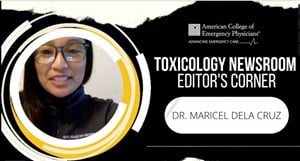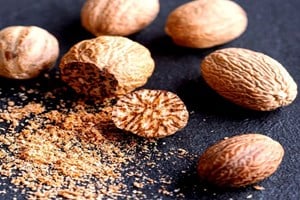
Chlorine
Patient Case
A 30 year old female presented to the emergency department with shortness of breath after a chlorine gas exposure. She was relaxing by a pool at the hotel she was staying at during a business trip. A hotel employee emptied some buckets of chlorinated agent into the water. Not long after this she noticed dyspnea, lightheadedness and nausea. She called 911 and was brought to the ED. EMS personnel empirically placed her on supplemental oxygen for tachypnea. She had no past medical history and took no meds. On initial evaluation by ED staff showed tachycardia to 108, tachypnea to 34 and saturation of 88% on 8lpm non-rebreather. Her lungs revealed wheezing, no other abnormalities on physical exam. Her blood gas showed pH of 7.08, pCO2 of 64, pO2 of 80. A CXR showed bilateral pulmonary edema. She was promptly intubated and admitted to the ICU on lung protective ventilation with FiO2 of 80%.
Household cleaners and the like
Chlorine gas exposures can occur in multiple ways as it is commonly used by the public as well as in industry. Multiple types of household cleaners are available to the public. A typical exposure scenario occurs when there is mixing of hypochlorite bleach with acidic products such as hydrochloric acid or ammonium containing cleaning products; this leads to the production of chlorine gas and chloramine gas respectively.1 These products include drain cleaners, rust/lime/calcium removers, and glass and window cleaners. These mixtures lead to emergency department visits from the public however this is only 3% of exposures while 70% of exposures are related to industrial or transportation accidents and a further 27% are related to swimming pool exposures such as the case above.2 Chlorine is used in manufacturing, water purification, textile and other manufacturing industries such as pharmaceuticals and cosmetics and many more.3 Patients of industrial accidents and patients with longer exposure typically have more severe symptoms, including respiratory distress and pulmonary edema. Most exposures are not this severe however. Of 5945 cases reported to the American Association of Poison Control Centers, none of these were fatal and only 13 had severe outcomes defined as patients who presented with life threatening conditions or were left with residual disability such as restrictive, obstructive or reactive airway disease.4
Chlorine gas: the chemistry
![]()
Chlorine is a yellow-green gas at room temperature and pressure that smells of pungent bleach. At pH values in vivo chlorine gas is rapidly converted to hypochlorous acid and hydrochloric acid which cause oxidative damage to the cells and leads to the edema and soft tissue injury seen clinically.5 Patients may have burning of in the eyes, rhinorrhea/irritation of the nose and mouth, lacrimation, headache, pulmonary edema, dizziness and syncope. Skin symptoms may range from irritation to necrosis and ulceration, especially if in contact with liquid chemical. Chlorine gas has intermediate water solubility, and while up to 90% may be absorbed by proximal airways, higher concentrations are able to reach and damage distal airways.4 Upon inhalation of chlorine gas immediate gag and cough reflexes occur but lung injury may progress over hours to days. Symptoms are significantly dose dependent. In severe exposures sudden death can occur via laryngeal edema, tracheobronchial tree edema or pulmonary edema. Chest X-rays rarely have any acute findings in household cases but may demonstrate pulmonary edema.4,1 Ultimately hyperchloremic acidosis may occur alongside cardiopulmonary arrest. Chlorine gas may displace oxygen concentration at sea level leading to a hypoxic environment.
The Treatment
A number of treatments have been suggested but no specific antidote exists. As always good supportive care is often key to survival. Racemic epinephrine may be used for children who develop stridor. As always with eyes, flush with water until a neutral pH is achieved.5 Bronchodilators may be used to treat bronchospasm but the evidence is limited; Rolipram, triptolide, budesonide IM were developed for lung injury due to chlorine and while theoretically counteract inflammation, pig data and anecdotal human evidence is all that is available to suggest its efficacy.1,2,3,4 Nebulized sodium bicarbonate is another proposed treatment with somewhat better evidence from two case reports, a prospective, randomized control study and four observational studies. The two case studies used approximately 4cc of 3.75% nebulized sodium bicarbonate and in both cases patient symptoms rapidly resolved.5,6 The observational studies have showed mixed results, some of which showed resolution of the symptoms, while others showed no comparable advantage to either placebo or steroids.4 The only prospective trial available with 44 patients showed very little difference when testing sodium bicarbonate vs placebo with improved FEV1 within 2-4 hours but was not designed to draw conclusions about long term patient oriented outcomes.7 Ultimately most patients survive to discharge, though one in 10 have some residual clinical features though studies are limited to lack of reliable follow up.8
References
- Cevik Y, Onay M, Akmaz I, Sezigen S Mass Casualties from Acute Inhalation of Chlorine Gas. Southern Medical Journal. 2009;102(12):1209-1213. doi: 10.1097/SMJ.0b013e3181bfdc67.
- Govier P, Coulson JM. Civilian exposure to chlorine gas: A systematic review. Toxicology letters. 2018 Sep 1;293:249-52.
- Winder C. The toxicology of chlorine. Environmental research. 2001 Feb 1;85(2):105-14.
- Vajner JE 3rd, Lung D. Case files of the University of California San Francisco Medical Toxicology Fellowship: acute chlorine gas inhalation and the utility of nebulized sodium bicarbonate. J Med Toxicol. 2013;9(3):259-265. doi:10.1007/s13181-013-0309-8
- Learn More Pub Chem. Chlorine (Compound)
- MRVOS R, DEAN BS, KRENZELOK EP. Home Exposures to Chlorine/Chloramine Gas. Southern Medical Journal. 1993;86(6):654-657.
- Wigenstam E et al; Toxicology 328: 40-7 (2015)
- Hoyle GW et al; Toxicol Appl Pharmacol 298: 9-18 (2016)
- Learn More Chang W et al; Toxicol Appl Pharmacol 263 (2): 251-8 (2012)
- Vinsel PJ. Treatment of acute chlorine gas inhalation with nebulized sodium bicarbonate. J Emerg Med. 1990;8(3):327-329. doi:10.1016/0736-4679(90)90014-m
- Douidar SM. Nebulized sodium bicarbonate in acute chlorine inhalation. Pediatr Emerg Care. 1997;13(6):406-407. doi:10.1097/00006565-199712000-00014
- Aslan S, Kandiş H, Akgun M, Cakir Z, Inandi T, Görgüner M. The effect of nebulized NaHCO3 treatment on "RADS" due to chlorine gas inhalation. Inhal Toxicol. 2006;18(11):895-900. doi:10.1080/08958370600822615
- Govier P, Coulson JM. Civilian exposure to chlorine gas: A systematic review. Toxicology letters. 2018 Sep 1;293:249-52.



